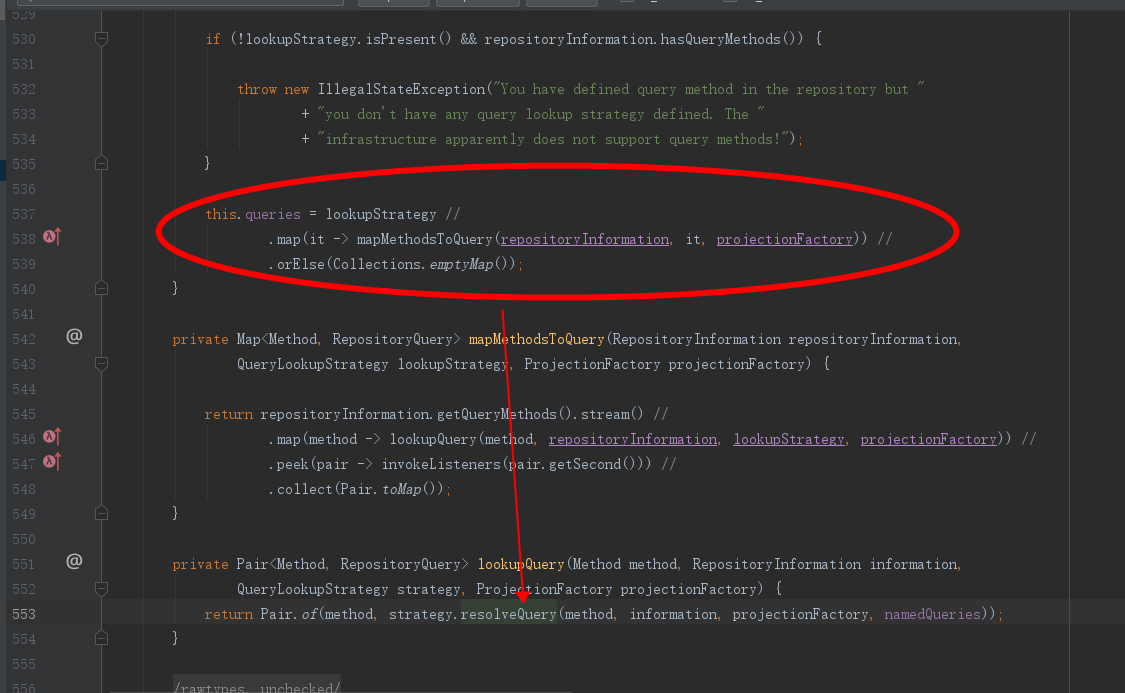接上文
可以看到queries在new的时候初始化,将repository中需要代理的方法和具体实现类也就是RepositoryQuery实现类放入其中,然后再拦截器中判断并执行实现的方法即:

1
2
3
4
5
6
7
8
9
10
11
12
13
14
15
16
17
18
19
20
21
22
23
24
25
26
27
28
29
30
31
32
33
34
35
36
|
public Object execute(Object[] parameters) {
ParametersParameterAccessor accessor = new ParametersParameterAccessor(this.queryMethod.getParameters(), parameters);
CriteriaQuery query = this.createQuery(accessor);
if (this.tree.isDelete()) {
Object result = this.countOrGetDocumentsForDelete(query, accessor);
this.elasticsearchOperations.delete(query, this.queryMethod.getEntityInformation().getJavaType());
return result;
} else if (this.queryMethod.isPageQuery()) {
query.setPageable(accessor.getPageable());
return this.elasticsearchOperations.queryForPage(query, this.queryMethod.getEntityInformation().getJavaType());
} else if (this.queryMethod.isStreamQuery()) {
Class<?> entityType = this.queryMethod.getEntityInformation().getJavaType();
if (query.getPageable().isUnpaged()) {
int itemCount = (int)this.elasticsearchOperations.count(query, this.queryMethod.getEntityInformation().getJavaType());
query.setPageable(PageRequest.of(0, Math.max(1, itemCount)));
}
return StreamUtils.createStreamFromIterator(this.elasticsearchOperations.stream(query, entityType));
} else if (this.queryMethod.isCollectionQuery()) {
if (accessor.getPageable() == null) {
int itemCount = (int)this.elasticsearchOperations.count(query, this.queryMethod.getEntityInformation().getJavaType());
query.setPageable(PageRequest.of(0, Math.max(1, itemCount)));
} else {
query.setPageable(accessor.getPageable());
}
return this.elasticsearchOperations.queryForList(query, this.queryMethod.getEntityInformation().getJavaType());
} else {
return this.tree.isCountProjection() ? this.elasticsearchOperations.count(query, this.queryMethod.getEntityInformation().getJavaType()) : this.elasticsearchOperations.queryForObject(query, this.queryMethod.getEntityInformation().getJavaType());
}
}
|
看到这里终于简单明白了spring-data的拦截和封装流程!而我们最开始提到的那个问题也在这个方法里找到了答案
1
2
3
4
5
6
7
|
public <T> T queryForObject(CriteriaQuery query, Class<T> clazz) {
Page<T> page = this.queryForPage(query, clazz);
Assert.isTrue(page.getTotalElements() < 2L, "Expected 1 but found " + page.getTotalElements() + " results");
return page.getTotalElements() > 0L ? page.getContent().get(0) : null;
}
|
原来是数据重复了,删掉重复的数据或者按照查询集合的方法规则(如下,returnType为集合类型即可)即来写即可!~
1
2
3
4
5
6
7
8
9
10
11
12
13
14
15
16
17
18
19
|
public boolean isCollectionQuery() {
if (isPageQuery() || isSliceQuery()) {
return false;
}
Class<?> returnType = method.getReturnType();
if (QueryExecutionConverters.supports(returnType) && !QueryExecutionConverters.isSingleValue(returnType)) {
return true;
}
if (QueryExecutionConverters.supports(unwrappedReturnType)) {
return !QueryExecutionConverters.isSingleValue(unwrappedReturnType);
}
return ClassTypeInformation.from(unwrappedReturnType).isCollectionLike();
}
|
附注:大部分的判断到底是删除还是查询还是更新等的标准
1
2
3
4
5
6
7
8
9
10
11
12
13
14
15
16
|
private static final String QUERY_PATTERN = "find|read|get|query|stream";
private static final String COUNT_PATTERN = "count";
private static final String EXISTS_PATTERN = "exists";
private static final String DELETE_PATTERN = "delete|remove";
private static final String DISTINCT = "Distinct";
private static final Pattern COUNT_BY_TEMPLATE = Pattern.compile("^count(\\p{Lu}.*?)??By");
private static final Pattern EXISTS_BY_TEMPLATE = Pattern.compile("^(" + EXISTS_PATTERN + ")(\\p{Lu}.*?)??By");
private static final Pattern DELETE_BY_TEMPLATE = Pattern.compile("^(" + DELETE_PATTERN + ")(\\p{Lu}.*?)??By");
private static final String LIMITING_QUERY_PATTERN = "(First|Top)(\\d*)?";
private static final Pattern LIMITED_QUERY_TEMPLATE = Pattern
.compile("^(" + QUERY_PATTERN + ")(" + DISTINCT + ")?" + LIMITING_QUERY_PATTERN + "(\\p{Lu}.*?)??By");
|
